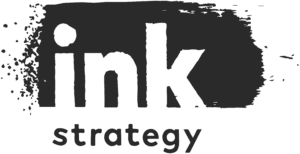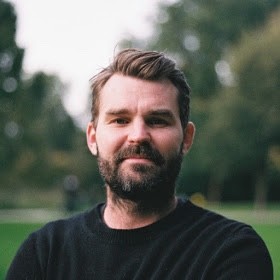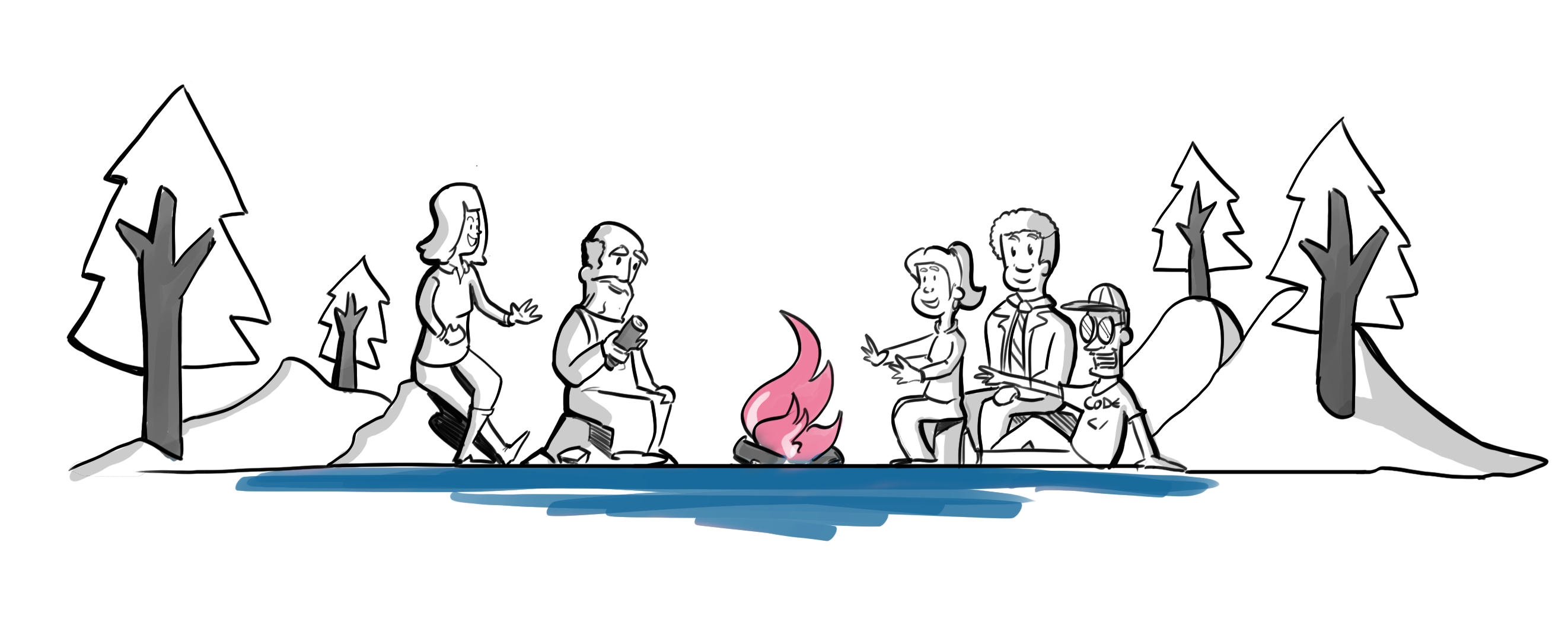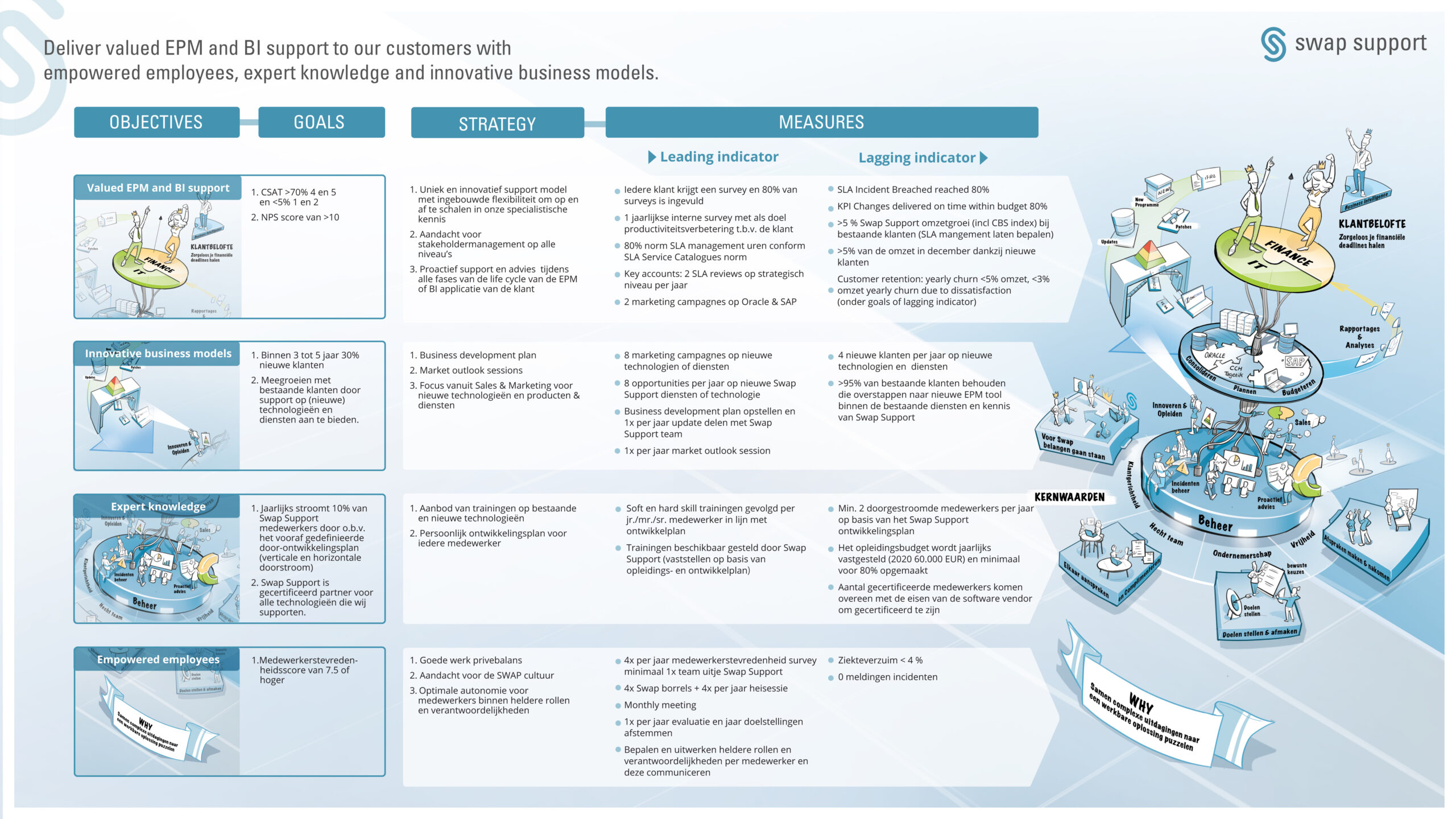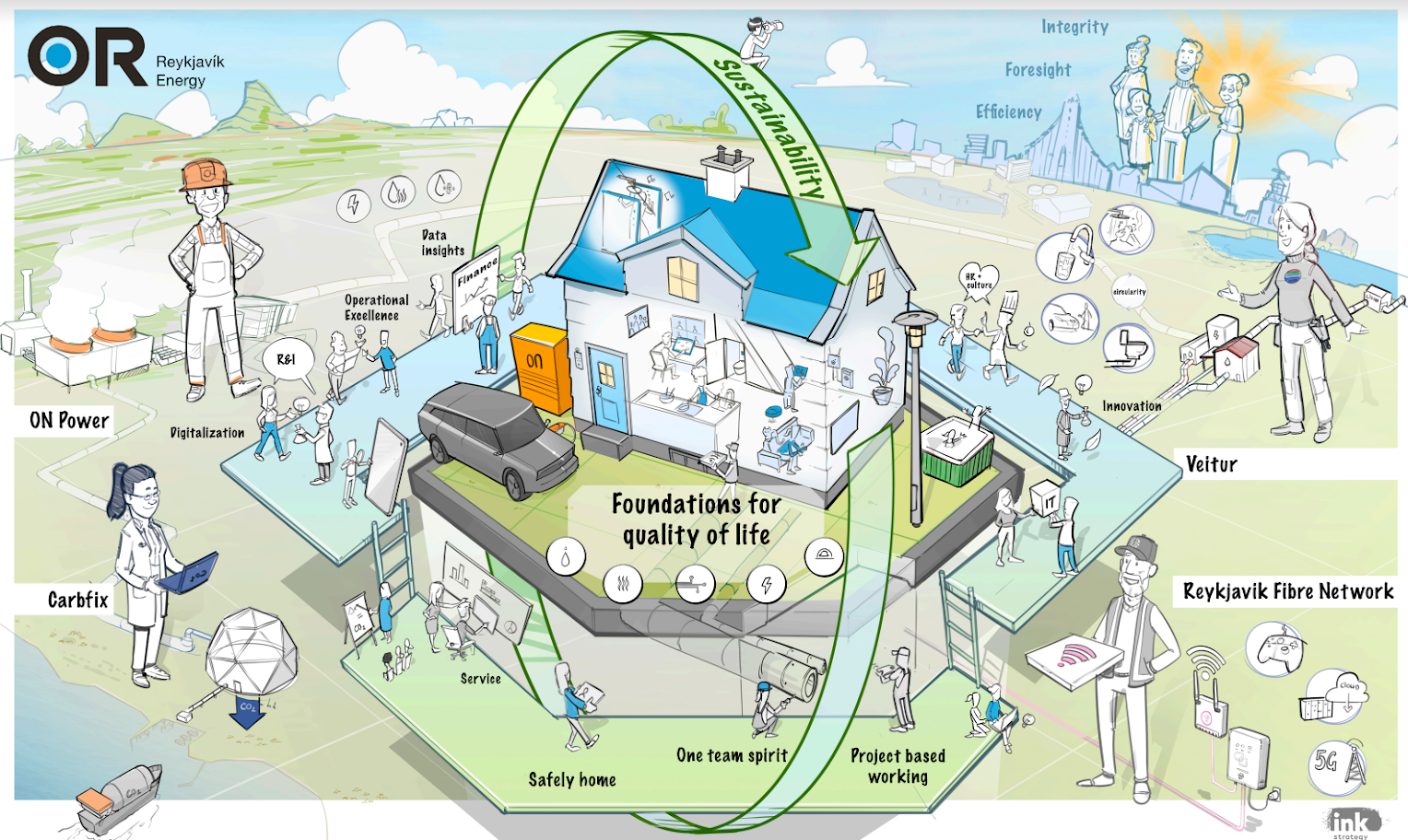Everything you need to know about storytelling to make your story stick.
What brainstorming is.
‘Let’s have a quick brainstorm’ is used far too often in the wrong context. Brainstorming is about; creating a safe atmosphere for sharing new ideas that will evolve into better ideas, where creative thinking is directed toward solving a clearly defined problem statement, and where people can build and create infinite possibilities. A brainstorm is a symbolic space where quantity trumps quality and where people work together to develop an imperfect solution. During brainstorming, we are setting ourselves up with lots of ideas to choose from but this process needs to come to an end and we need to make choices. This article will give you some methods to use during brainstorming.
What brainstorming isn’t.
Nothing is more deadly for creativity than sharing your idea and being laughed away by your colleagues or even worse, your superior. Next time you have an idea you’ll think twice about sharing it. Brainstorming is not a place to be critiqued, ridiculed, or judged by the quality of your idea. The heart of every thriving business, large or small, is their people and the collective ability to find creative solutions. A good brainstorming session to come up with new ideas can be the catalyst or breakthrough needed to thrive.
What brainstorming is
A process for generating a large number of ideas or solutions to a problem.
A collaborative and non-judgmental approach to ideation.
An approach for stimulating creativity and innovation.
A way to encourage participation and engagement from all members of a team.
What brainstorming isn't
A platform for making decisions.
A forum for criticism or evaluation of ideas.
A solo activity.
A linear process with a set structure or agenda.
A method for solving problems that require immediate and definitive answers.
Read further if you …
- are looking for tried and tested brainstorming techniques
- are struggling to get the most out of creative meetings
- want more engaged problem-solving employees
- want to tap into the infinite source of creative energy for your business.
Common mistakes in setting the stage for brainstorming.
Before you begin, setting the scene is just as important as choosing the right model to work with. Here are 8 common mistakes
Introducing the double diamond
Within the design thinking space, we often talk about the ‘double diamond’ model. It’s a structured approach to problem-solving. In a double diamond, we move from the customer to a tested solution.
Briefly explained; the first diamond is all about understanding the context of a user and defining a problem statement to be solved. The second diamond is focused on designing a solution and delivering it. What is interesting about this model is that there are generally two types of thinking needed; (1) divergent thinking and (2) convergent thinking.


Divergent thinking is a thought process typically used to generate new ideas. Like brainstorming, it is typically more exploratory and creative in nature through the free-flowing, spontaneous nonlinear manner that many ideas are generated. Not all ideas are good because they are created often under time pressure and in the chaos unexpected connections are drawn out. Brainstorming tools can be helpful to structure creative thinking when diverging.
Convergent thinking follows divergent thinking in that the ideas then need to be synthesized, organized, and evaluated in order to choose the best. This is often characterized by a set of logical steps that need to be followed or predetermined criteria used to filter out one solution and sometimes the right solution.
What we often see is that these two types of thinking get mixed up and people are doing divergent and convergent thinking at the same time. One person is brainstorming new creative ideas and the other is calculating how feasible it is. This is a recipe for creativity destruction.
Choosing the right brainstorming tool
In order to steer creative sessions in the right direction it helps to have a list of a few tried and tested brainstorming techniques that can you can use to facilitate a group discussion. All of these tools amplify divergent thinking and promote creative problem-solving.
1. Big guess Design can be daunting. One way to start ideation is to develop a “big guess” You can revert back to the following structure to outline your hypothesis. The guess is big enough that it can change and be refined during the process. Build a big guess and revisit it as you move through your design process.
Our <name of service> will help provide <these benefits> to <user profile/s> because <it addresses the big problem> by <doing these things>. It will work because <unique reasons>.
2. The vision of perfect is a visual approach. Assume that users have adopted your proposed solution. Make a visualization of what success looks like. Pick a time in the future and describe the ideal outcome on that day in as much detail as possible. Use visualizations to describe the technology, people, and processes that are being used at that moment.
3. Coverstory is another way to envision the future. Within the relevant field choose a headline magazine or newspaper and imagine your idea has made it to the front page cover. What would the possible cover story be about? Choose a key image, title, and some quotes that would go on the front page. Add a short description of the article to entice people to open the magazine and leaf towards the article. You can use cover stories to get very specific on your envisioned future. Work in groups and present the ideas to each other as you would in an editor’s room.
4. Persona journey mapping: This is a tool designed to explore and create an experience for users of a product or service. You visualize the different steps or processes that a person goes through to accomplish a goal. Journey mapping starts with defining a fictitious ‘ Persona’ and compiling a series of actions they take along a timeline. Next, the timeline is fleshed out with emotions and thoughts to develop a narrative of all of the potential pain points that can be used for brainstorming.
5. How Might We’s (HMW): are simple specific questions that identify a part of a larger solution space. Under time pressure people rotate through a number of HMW’s to find creative solutions to that problem building upon each others’ ideas. Good HMW’s are based on insights into the problem and are not suggestive. They are a great way to launch brainstorming.
6. Brainwriting: Everyone who participates gets the chance to write in silence for a period of time to get all their own ideas onto paper. The reason you would use this as a brainstorming technique is to ensure that no one dominates the discussion with their idea. Introverts get as much airtime as extroverts to express their ideas.
7. Crazy eights or rapid ideation: In a crazy eights brainstorming participants are given a piece of paper with eight open boxes for them to quickly develop eight ideas under time constraints. The participants are asked to make sketches of the possible ideas they come up with. Parkinson’s law shows us that we spend as much time on our work as we have available. This technique maximizes productivity and results and is great for teams with little time or who are easily distracted by each other’s ideas.
8. Morphological charts: This is a systematic and structured method in which you split up the problem or solution into smaller parts that can then be ideated on. Afterward, those part solutions can be mixed and matched to find new creative design solutions. When combining the different parts don’t go for the safe ideas but choose weird combinations to ideat from. The benefit of using this method is that it forces creativity through a rigorous process- great for more analytical thinkers with endurance.
9. Team charter: this model is a fun way to have a brainstorm about team dynamics before you embark on a project together. Get to know each other and what their strengths and weaknesses are by filling in this team-building template. Explore what you can expect from each other in order to hold each other accountable later. A creative way to kick off collaboration.
10. Behavioral habit design: Designing behaviors can be a powerful tool to change. Once an envisioned direction has been chosen you can encourage specific behaviors to ensure the desired outcome can be translated to day-to-day. Start by mapping which habits people already have then stack new habits onto existing ones or make the habits more or less obvious, attractive, easy, or satisfying. A difficult but valuable technique.
11. A value proposition canvas is used to map out how an envisioned product or service will add value to a customer. It has two parts. The customer profile describes the jobs your customer is trying to get done and highlights the pains or negative outcomes and gains or positive outcomes that they strive to achieve. The second part of the map is the value map in which you list the services or products your company will perform and explain how that will be a pain reliever or a gain creator for customers. This technique is great in find a clear fit between what customers want and what your product or service is doing.
12. Scamper Is a structured creative process to help a group with creative triggers to think outside the box and find a new idea through a number of clear steps. There are 7 steps following the acronym SCAMPER that help reframe an existing product or topic from different perspectives.
- Substitute: replace or substitute the product to find something that is equal.
- Combine: add information to the existing product and combine to find new ideas.
- Adjust: identify ways to construct the product in a more flexible or adjusted material
- Modify: magnify or minimize the product to explore other scaled ideas
- Put into other uses: explore other ways to use the product that you might not initially have thought of
- Eliminate: parts of the product that aren’t valuable and see where that brings you
- Reverse: rearrange the way you use the product to evolve the product from the original concept.
This technique works well to add structure to the creative process if needed.
13. Eidetic image method starts with a group of people closing their eyes to imagine the current product or service in their minds. After opening their eyes they discuss what it looks like. Followed by another closed-eye session to envision a new and improved version. They are asked to visualize new features or improved performance and then share in detail what they have envisioned. This technique works well when a group is improving an existing product of service.
14. Thinking hats When exploring a new idea you wear figurative ‘thinking hats’ to give participants different roles in the session. There are six thoughts that will allow participants to look at a problem or idea from one specific angle.
- The Blue hat (conductor) manages the decision making process and asks for summaries and comes to conclusions
- The Green hat (creative) comes us with creative ideas and thinks in infinite possibilities and solutions
- The Red hat (heart) acts from the heart and follows instinct. This hat doesn’t need to think logically
- The Yellow hat (optimist) looks at problems in an optimistic way and sees possibilities and advantages to everything.
- The Black hat (judge) is very critical and seeks to highlight potential danger or risk in everything
- The White hat (factual) is neutral and shares a lot of facts and statistics. Focus on objective reasoning. One person must be the facilitator (royal hat). This brainstorming technique is great to get an inclusive overall picture.
15. Scenario planning is a technique to identify future possible scenarios based on different uncertainties. Start by identifying two axes of future uncertainties and then create four different future scenarios. In each scenario brainstorm what the future would look like then highlight the key elements of each scenario. Choose one scenario that is most likely going to happen and further refine it. This technique works well to explore relevant but alternative futures and can be repeated.
16. Asynchronous brainstorming can be helpful when people are not all in the room at the same time. Hang up a question on an online or offline whiteboard and invite people to add ideas to the brainstorming when they have the time. Build off of each others’ ideas. This brainstorming technique is similar to the ‘idea box’ and can be effective when people are in different time zones or working online in collaboration tools like Mural or Miro.
Choosing the right tool for converging thinking
Below are some of the tools we think are more valuable when converging after a brainstorm. From decision-making models to step-by-step analysis templates that will help you move away from free-flowing borderless thinking and more towards decision-making and consolidation of the best ideas.
1. Context map is a framework to better understand what the boundaries are of your company or idea. Use this template with your team to map out the prevailing conditions and relevant trends and developments. It will help you understand the external forces that may influence your concept. Try focus thinking on what is coming not only the here and now. Re-visit this canvas at different moments to update what is relevant.
2. Game plan The design process can be overwhelming because of the endless opportunities and decisions. To tackle this, create a grid and categorize and prioritise specific things you want to focus on during the design process. What must you do, should you do, and what could you do? Work systematically through this post-it plan and move things around to stay on track with expectations.
3. Product Linchpin Identify what is the hardest and most critical part of your solution. This is your linchpin. Use lean start-up to gather learnings about these linchpins and work your way through them step by step.
4. Critical assumptions Blind spots can be the downfall of a great idea. When analyzing an idea or problem statement, write down all the most critical assumptions you have and organize them accordingly using how likely or unlikely they will happen and how large the impact will be if the assumption is incorrect. Systematically work through the assumptions to move them around to eliminate your blind spots.
5. A validation canvas can be used to test and structure progress along the riskiest assumptions. What is the possible strategic shift or ‘pivot’ if the assumption is incorrect? Use pivots to strengthen the roadmap and open up possibilities. Design is all about not getting married to your first ideas or ‘kill your darlings’ to set yourself up to be agile.
6. Storyboards are a great way to get pragmatic about your proposed new solution. It works great for new physical solutions. Grab a pen and develop comic strip visualizations with different steps a user will take to interact with the new solution. A storyboard is a great way to show stakeholders how it works. Drawing very elementary visuals often works just as well as high-quality illustrations so don’t set the bar too high.
7. User journey mapping is a great tool to identify and improve current problems in an existing users’ interactions with a product or service. Start by mapping out the user’s needs. Then define the steps taken when interacting with the service. Identify key moments and touchpoints between the service and the user, and describe the experience. Identify the highs and lows in the entire journey from start to finish. Use this overview to choose a problem space to improve. One way to organize the journey is with the 5 e’s model.
8. Product roadmap Create an overview of the steps that must or could be taken chronologically. Use a product roadmap to distinguish between must haves and nice to-haves and continue coming back to this overview as your progress.
9. Root cause analysis (5 why’s) In order to create a deeper understanding of the specific problem you are analyzing you can work through a rudimentary root cause analysis with the 5 why’s tool. By asking ‘why’ five times you get a broader understanding and see more perspectives around the challenge at hand. This is a dialogue tool to explore the challenge.
10. Stakeholder map; it is often difficult to frame who the target audience is. Working through a stakeholder map helps to get an overview of all of the relevant stakeholders and their roles and expectations towards your solution. Will they be champions or opponents and who to focus on?
- Step 1: Identify the different individuals that you are targeting and that may be affected by your work.
- Step 2: Organize them according to the categories of core users (those who interact with your intervention) direct stakeholders (those that influence your intervention) and wider network (those that won’t have direct influence). Connect them with lines to map out key relationships or highlight key expectations.
- Step 3: Clarify if the individuals are going to be champions or opponents to your intervention and why. Prioritize your focus.
11. A SWOT matrix could be considered a brainstorming tool but it also helps to provide an analysis of the relevant environment of a new idea. It can provide new insights and help to understand and capture the context and assess the feasibility of a concept. SWOT stands for strength, weakness, opportunity, and threats;
Strength: what are the current strengths?
Weaknesses: What are the weaknesses?
Opportunities: Which opportunities to we see in the future?
Threats: Which threats are looming?
13. An experiment canvas can help you design an experiment to test a prototype. We often build prototypes to validate an assumption so start by identifying why and what you are testing. Be mindful to design an experiment that tests that specific assumption and think through how you will capture the results and come to a conclusion. Get comfortable testing your ideas with your target audience to drive a successful design project.
If you want to get the most out of your next creative session and are interested in innovation coaching get in touch with Ink Strategy to discuss how we can design a learning sprint for your team to apply and work through some of these models.
Recent posts
The OGSM model is a strategic planning model that connects the dots in your strategic plan...
A bigger picture helps team collaborate, clarify ideas and empower the entire organisation...
